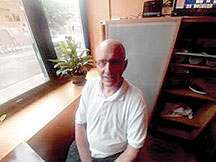
*
This is my interview with my old pal, Alan Ringel, experimental jazz producer and a founder of About Time Records. I met Al over 30 years ago at McLean Hospital, where we worked as counselors. Al talked about one of his artists Henry Threadgill, who just won the Pulitzer-Prize, the “jazz loft” scene in the 70s in NYC, the role of improvisation and composition in jazz, misconceptions about Louis Armstrong, jazz writer Stanley Crouch, the jazz clubs in Greenwich Village, and much more. We had our discussion at the Thai restaurant Sweet Ginger in Union Square, Somerville.

Alan Ringel
Doug Holder: What is your definition of experimental jazz?
Alan Ringel: I think “experimental” is a decent word. It involves improvisation, a word that scares a lot of people. The idea that you are making it up as you go along is threatening.
DH: Why?
AR: I think in general it is a type of artistic expression that people don’t trust. This is because they think anyone can do it. Like Jackson Pollack, for instance. People thought he just threw paint on the canvas; and he got famous and rich. Improvisation is actually a skill you have to learn and master. You have to master the arrangement of music, composition, etc. You have to have the basics before you can effectively improvise.
DH: In the 1970s you experienced the jazz loft scene. Tell me about this. Was it a movement?
AR: Everything in hindsight is a movement. When you are actually doing it you don’t think of it that way. When I was living in New Jersey, right outside of New York City in the mid 70s, there were a number of important jazz musicians all living on the Lower East Side. All of the artists on the Lower East Side knew everyone else. So the jazz people knew the Abstract Expressionist painters, they all hung out together, they went to bars together, etc. But when you went to a concert you didn’t know there was this social scene of artists. I used to go to this club in Greenwich Village, the Five Spot. It was famous well before the 70s. It was around the corner from the Fillmore. The Tin Palace and a couple of other spots became popular around this time. Musicians were acquiring loft spaces in industrial buildings. They took these industrial spaces and created jazz lofts. And eventually this became a movement, Jazz Loft Music. It was really about contemporary jazz that was happening in New York City at the time. Sam Rivers and his wife had a space in a building that Robert Dinero’s mother owned, Studio Rivbea. During this time a lot of musicians were coming from the Midwest and California, and they were being recorded by independent jazz labels. An association was created, The Association for the Advancement of Creative Musicians. Getting back to the migration of artists to NYC, folks like Henry Threadgill and the Art Ensemble of Chicago took up roots there. Writers like Stanley Crouch relocated to the city. Later Crouch and Wynton Marsalis started the original Lincoln Center Jazz Repertory Series.
DH: Years ago you produced work by the celebrated jazz musician Henry Threadgill. Since then he recently won the Pulitzer. Has there been an upswing in sales for his album?
AR: I am sure there was an upswing somewhere. Our records came out years and years ago. They still sell. But we didn’t sell a lot more records because he won the Pulitzer. It is hard to find good distribution for independent labels. If we were a big record company we could sell more. Jerry Garcia once said, and I paraphrase, “Not many people like licorice, but the people that do really like it a lot.” That includes us. It is more true for us than the Grateful Dead.
DH: You are married to Lisa Houck, an accomplished print maker, graphic artist, etc. How does this work?
AR: Lisa has done two record covers for us. However, Lisa’s taste in music is quite different than mine.
DH: Threadgill, an innovative jazz artist, also uses the traditional jazz music of Jelly Roll Morton, and Scott Joplin. Can you speak about this?
AR: Henry has a degree in composition. Threadgill’s album Air Raid was composed with music of the two men you mentioned. Henry’s music is steeped in the music of New Orleans. Jazz, an American Art that started with African Americans, and the culture came from New Orleans. And remember, Louis Armstrong, who was born in New Orleans, was a great jazz innovator. Everyone knew Armstrong in the 70s. He was a creative avant-garde artist. His music was as easily sophisticated as anything Charlie Parker was doing. His small group sessions in the 1950s were as avant-garde as anything that was done in the 70s.















Reader Comments